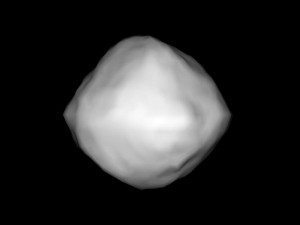The work of a University of Tennessee, Knoxville, professor has helped reveal a rare orbital shift and the density of an asteroid that will pass close to Earth.
Josh Emery, assistant professor of Earth and planetary sciences, and the team of the NASA asteroid sample return mission called OSIRIS-REx have measured the weight and orbit of 1999 RQ36. They have found the asteroid has a low density and its orbit has drifted roughly 100 miles in the last 12 years. This deviation is caused by the Yarkovsky effect.
“This Yarkovsky effect can actually push an asteroid into — or out of — the path of the Earth,” said Emery. “Understanding this force and how it affects an asteroid is critical for determining whether or not that asteroid will hit us.”
Emery’s work using NASA’s Spitzer Space Telescope in 2007 was crucial in determining the effect. He measured the asteroid’s thermal characteristics using infrared emissions and determined the space rock was covered in an insulating blanket of fine material — a key factor for the effect.
“The longer a surface can hold heat, the stronger the Yarkovsky effect,” said Emery. “Therefore, if the asteroid was made up of solid rock, the force would be stronger because it would retain heat longer. But fine material such as dust or sand heat up and cool down quickly so the effect is weaker.”
The Yarkovsky effect sharpens the picture of how potentially hazardous 1999 RQ36 could be in the future. The 1,640-foot diameter asteroid is expected to pass by Earth in 2135 at around 220,000 miles. At such close distances, the asteroid’s subsequent trajectory becomes impossible to accurately predict so close approaches can only be studied statistically.
Due to this discovery, scientists now have identified many low-probability potential impacts in the 2170s through the 2190s while ruling out others.
The Yarkovsky effect is named for the 19th-century Russian engineer who first proposed the idea that a small rocky space object would, over long periods of time, be noticeably nudged in its orbit when it absorbs sunlight and then re-emits that energy as heat. The effect is difficult to measure because it’s so infinitesimally small.
The effect was discovered on 1999 RQ36 in an effort to determine the mass of the asteroid from millions of miles away. The scientists needed the space rock’s size, thermal properties, propulsive force (Yarkovsky effect) and orbit to calculate the bulk density.
“Being able to find the weight of a solitary space object by using things like radar tracking and infrared observations might once have seemed almost science fiction,” said Emery. “But now we have the tools to do it and we just use our findings and solve for ‘x’ which is the density.”
The scientists discovered 1999 RQ36 has the density of water and is very porous.
“In addition to the excitement of the Yarkovsky results, we are excited to find that our asteroid consists mostly of dusts and rocks,” said Emery. “Therefore, we should be able to get a collect a good sample to bring back to Earth and study.”
The OSIRIS-REx spacecraft is scheduled to launch in 2016, arrive at the asteroid in 2019 and bring samples back to Earth in 2023.
Source: NASA
Artist's Impression Image: NASA

The aim of art is to represent not the outward appearance of things, but their inward significance. – Aristotle
















